Here’s A Hungarian Cabbage and Noodles Recipe To Make a Filling Comfort Dish!
Do you want a quick and easy recipe that is cheap and satisfying? Hungarian Cabbage and Noodles is definitely the recipe that you should try.
Known in Hungarian as Káposztás Tészta, this is a very simple dish made with shredded and fried cabbage, onion, egg noodles, and some oil and spices!
This dish is great for cold days when you’re feeling a little lazy and want something lightly fried, a little oily, slightly sweet, and totally delicious!
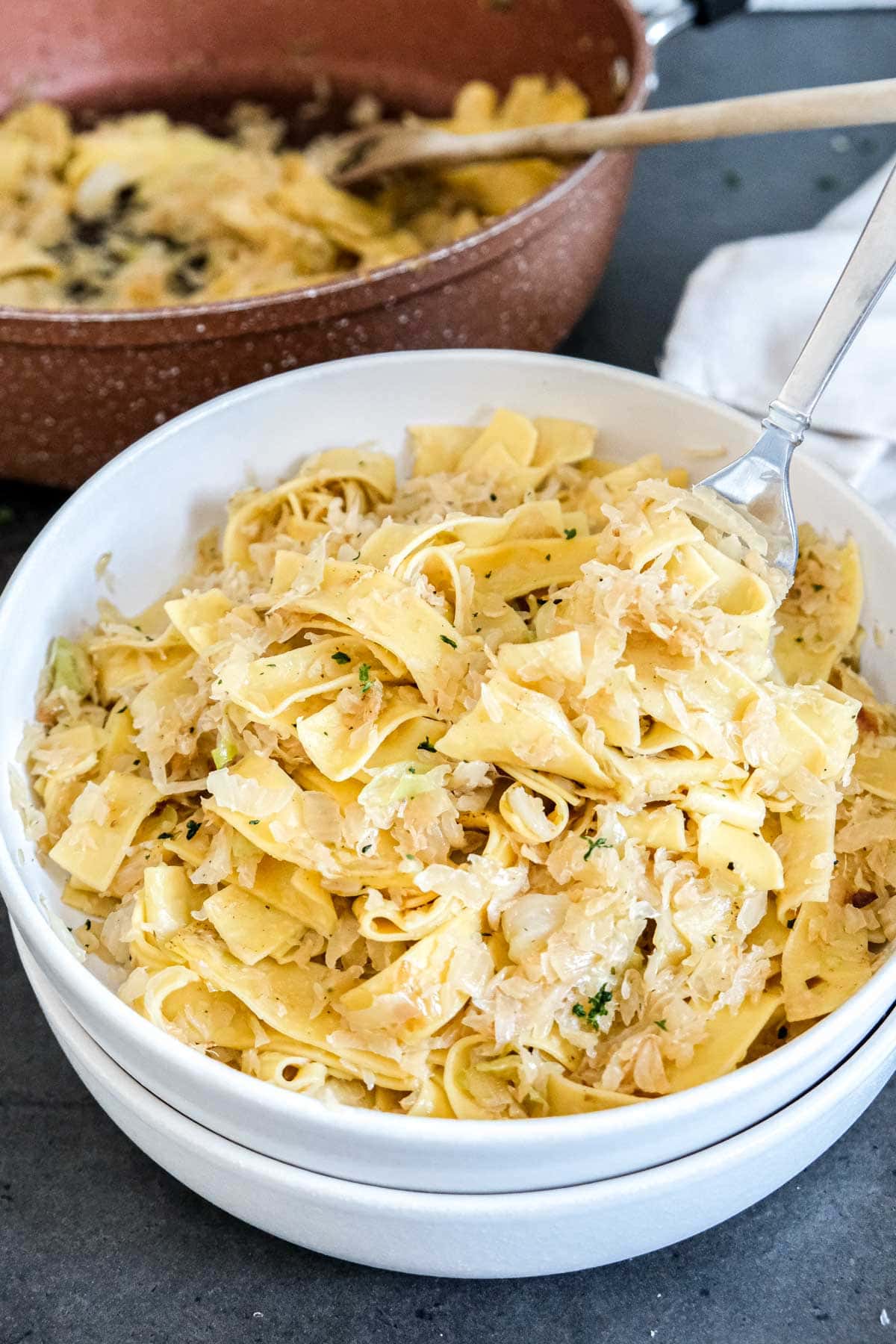
It’s a traditional Hungarian dish that Eric grew up eating made by his Hungarian nagymama (grandma), so we know it well and eat it often!
This dish has many different names and variations in other parts of Central and Eastern Europe. In Austria, for example, it is known as Krautfleckerl.
Some people also know this recipe for fried cabbage and noodles as “Haluski”. This is not to be confused with a similar recipe called “Bryndzové Halušky”, which is a national dish of Slovakia (made with potato dumplings and sheep’s cheese).
To make things even more confusing, a Polish dish of cabbage and noodles (usually square noodles without eggs) is called “Łazanki”.
This version often adds mushrooms, and meat such as bacon or kielbasa, and can be made with sauerkraut.
So, overall, don’t be confused by different names for very similar cabbage and noodle dishes. Here’s a recipe for the Hungarian version that Eric’s grandma taught him to make!
Ingredients
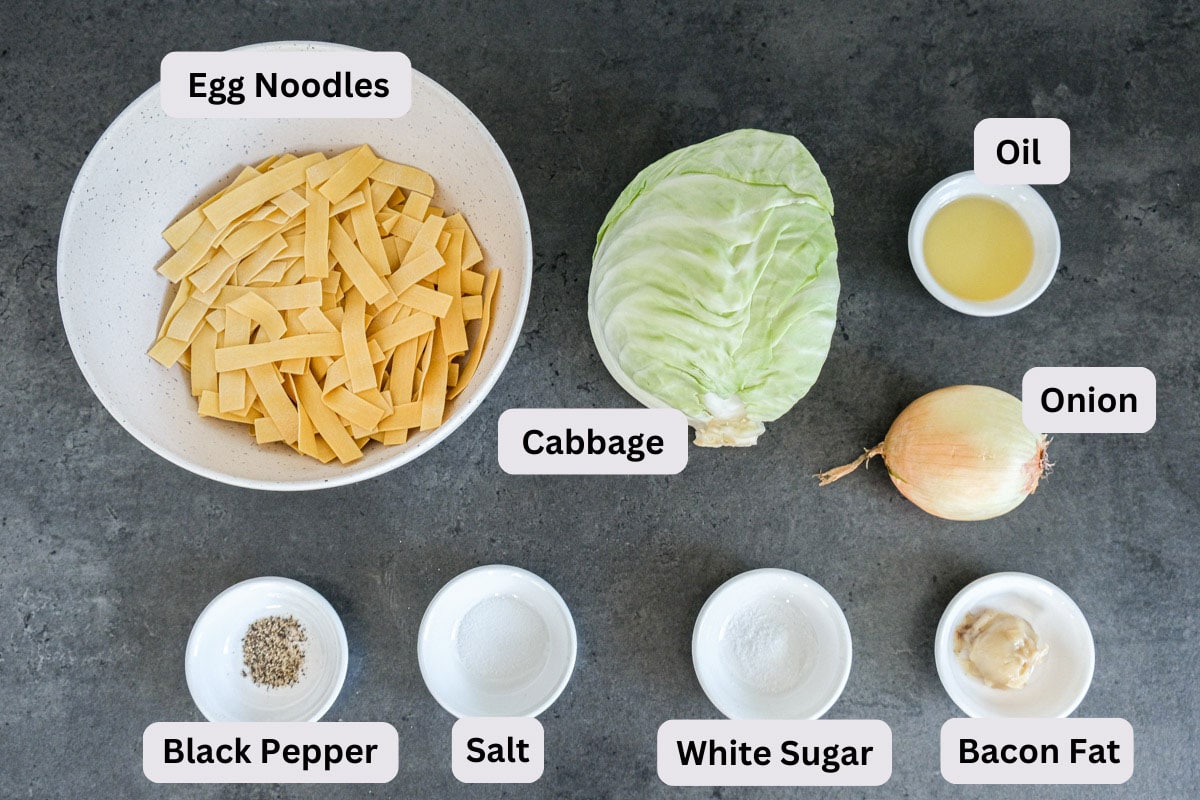
To make this Hungarian fried cabbage and noodles recipe, here are the ingredients that you will need. It’s a very simple dish that doesn’t break the bank.
- White cabbage – You’ll need about 1/3 of a medium cabbage.
- Onion – One medium-sized yellow onion.
- Egg noodles – Ideally, square egg noodles called kiskocka or longer, extra broad egg noodles.
- Oil – Use a neutral-flavored oil such as avocado, sunflower, or canola oil. Don’t use olive oil.
- Bacon fat – If you have bacon fat, you can use that. Alternatively, you can use lard, butter, or oil.
- Salt – To enhance the overall flavor of the dish.
- Black pepper – Adds a hint of spice.
- Granulated sugar – Adds a touch of sweetness to balance the flavors.
Recipe Tips and Substitutions
Before you head off to make these Hungarian cabbage noodles, have a quick read through these recipe tips and substitutions so that your cabbage noodles turn out delicious:
- This recipe is traditionally made with classic Hungarian square egg noodles called kiskocka. We used extra broad egg noodles which are a little longer. Other types of egg noodles or noodles without eggs will also work.
- Cutting the cabbage into smaller wedges makes it easier to hold and shred. You can use a (box) grater to shred the cabbage or dice it finely using a knife.
- Usually animal fat – often pork – is used to fry the onions and cabbage. If you don’t have any, you can substitute butter or oil.
- Use a neutral-tasting oil, such as avocado, sunflower, or canola oil so it doesn’t change the overall flavor of the dish.
- We didn’t add bacon, but you can. Cut it into small pieces and add it while sautéing the onions.
- You can also add cut-up sausage, such as kielbasa, to this dish if you want.
- You can add a little bit of Hungarian paprika – but we don’t usually do that. Just because it’s Hungarian, doesn’t mean every dish needs paprika!
How to Make Hungarian Cabbage and Noodles – Step by Step Instructions
In this section, we’ll show you exactly how to make these cabbage noodles.
We’ve included all the recipe process photos so that you can follow along at home and track your progress.
If you want to get started cooking right away, you can find the detailed recipe card with exact measurements and steps at the bottom of this post!
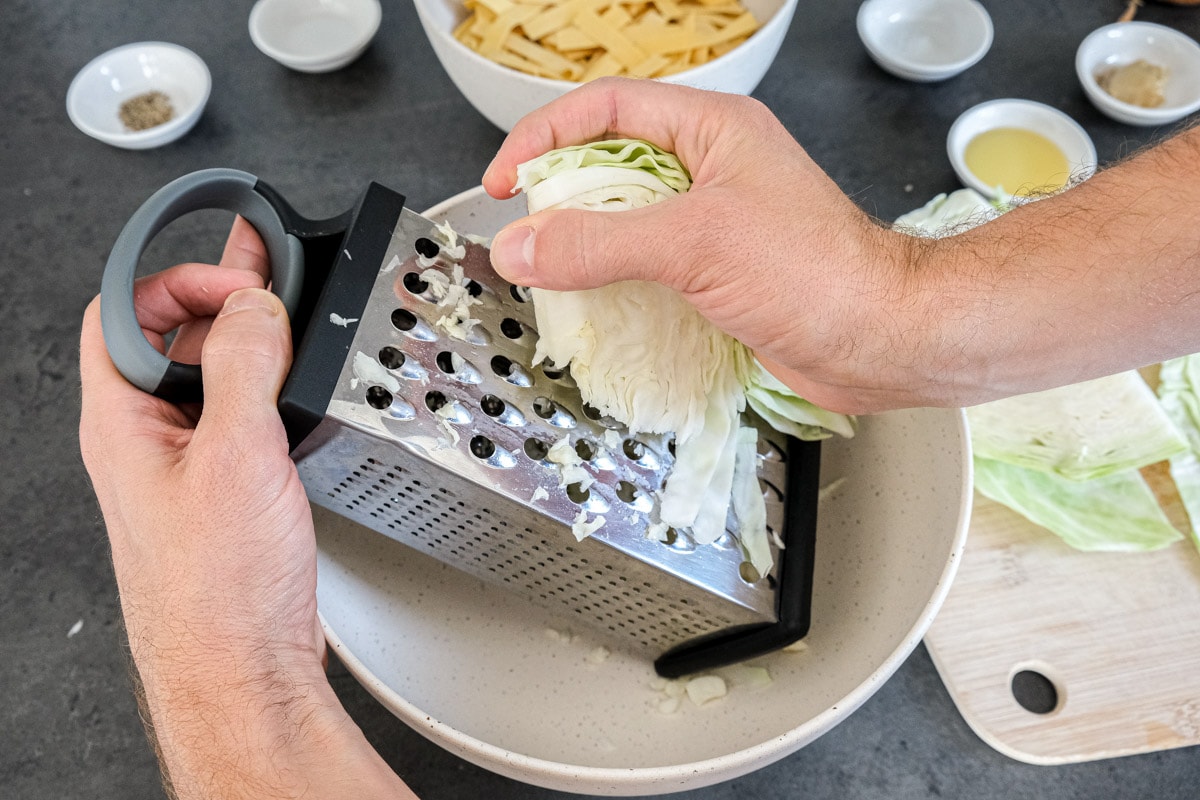
Remove the outer leaves from the cabbage. Then cut it in half and remove the core. Use a grater to shred enough cabbage to make about 5 1/2 cups of shredded cabbage.
If you don’t have a grater, you can also chop it very finely with a knife.
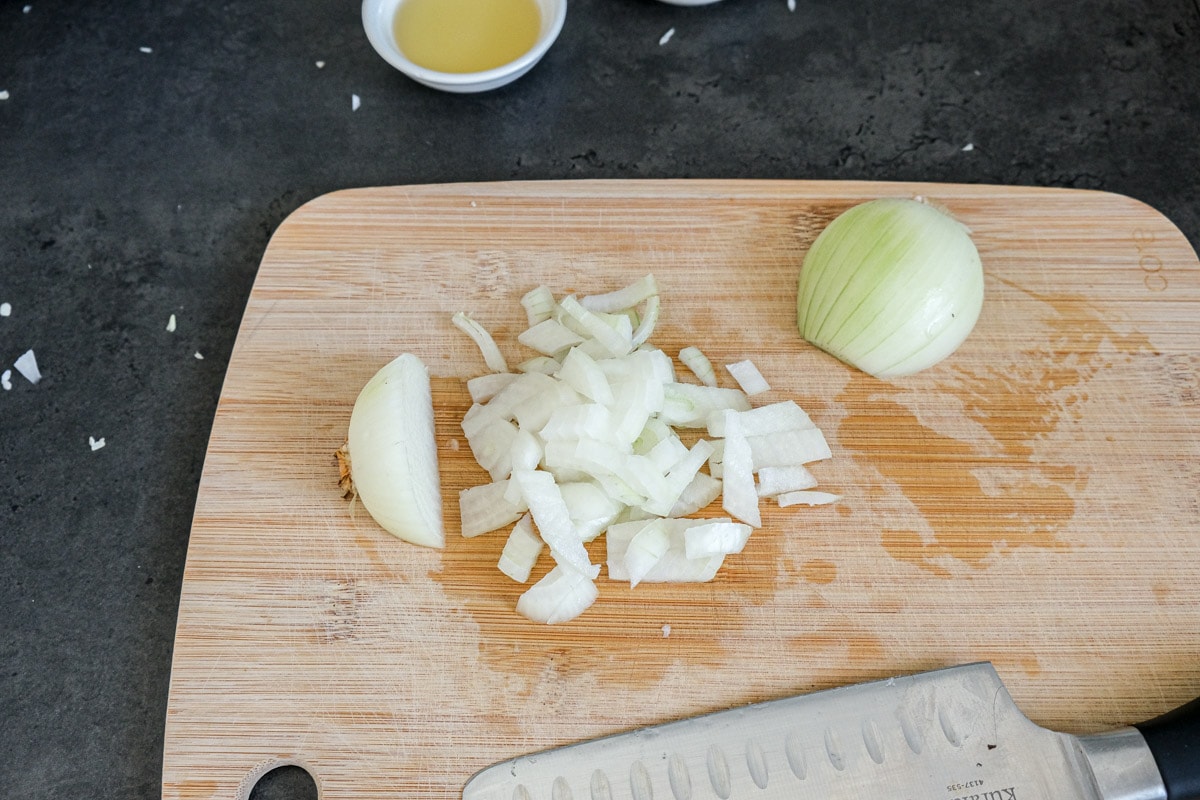
Peel and finely chop the onion.
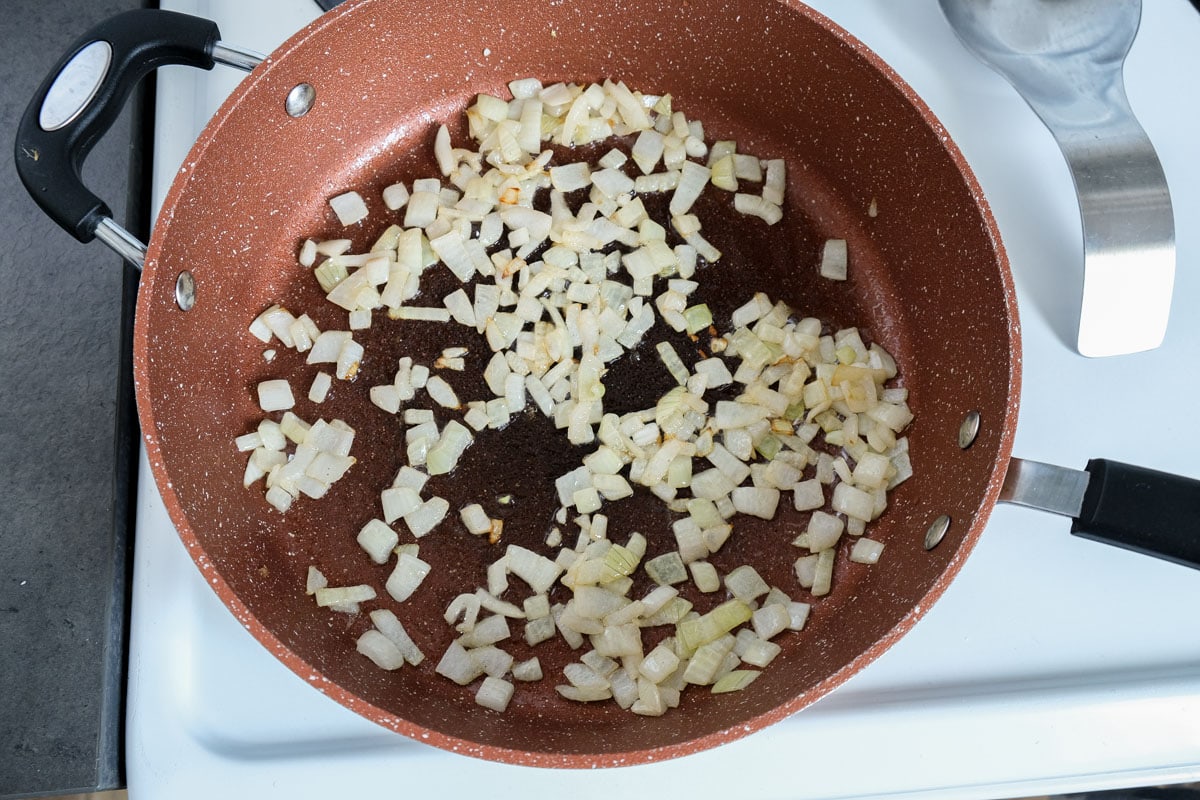
Heat the oil and bacon fat (optional) in a large pan with high sides.
Add the diced onion and sauté until translucent and beginning to brown, about 5 minutes. Stir frequently.
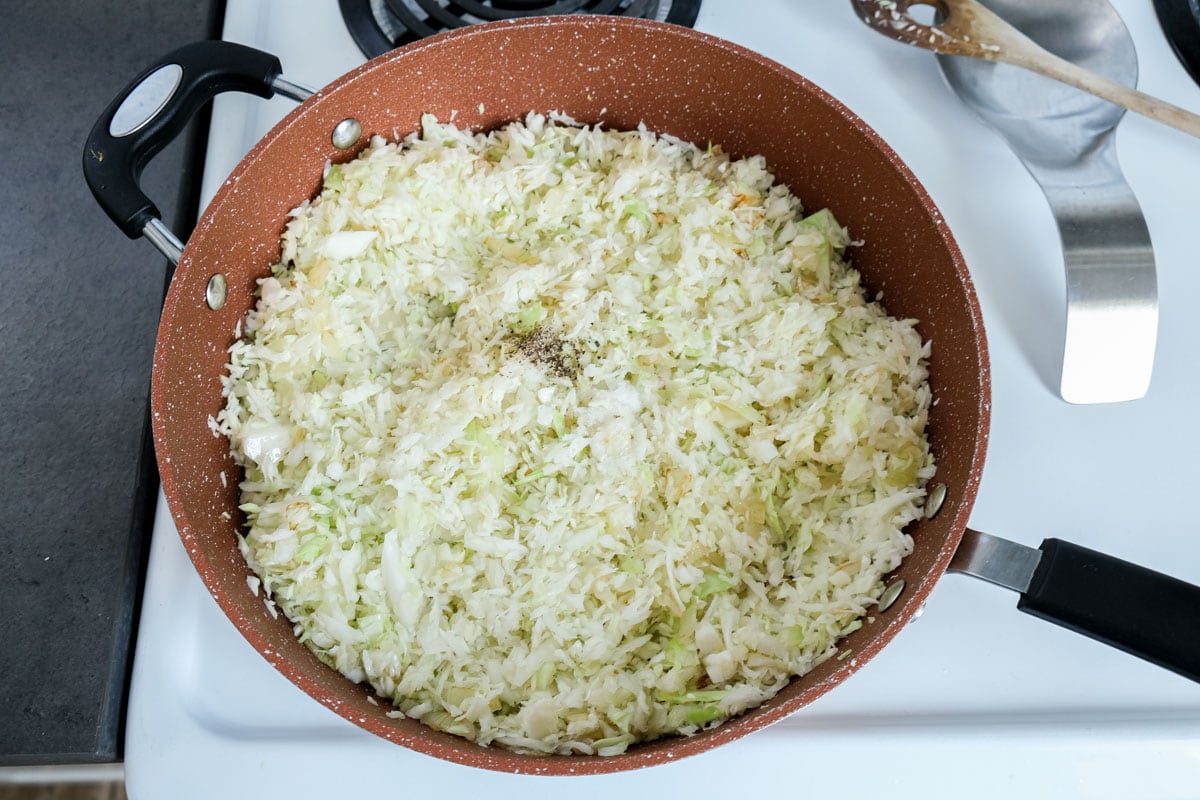
Add the shredded cabbage, salt, pepper, and sugar to the pan.
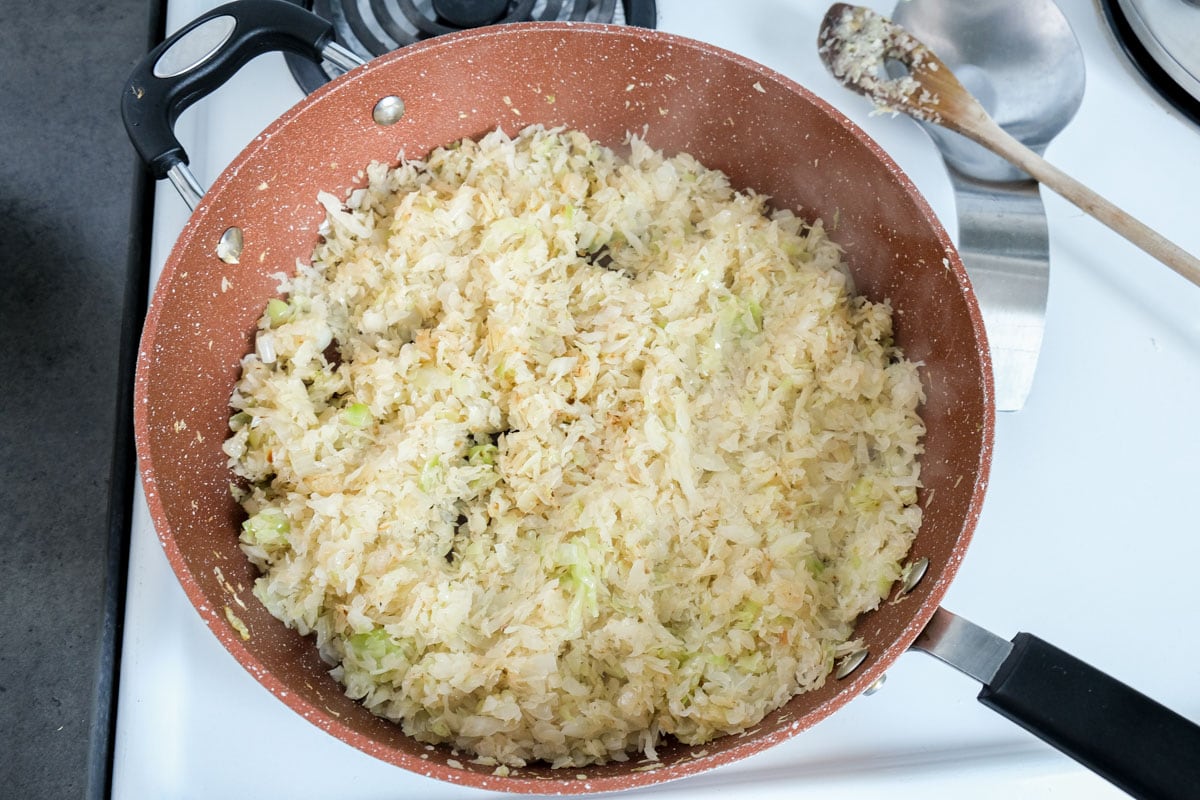
Cook over medium-high heat for about 10-12 minutes, stirring regularly, until the cabbage is soft and beginning to brown. Then turn down the heat.
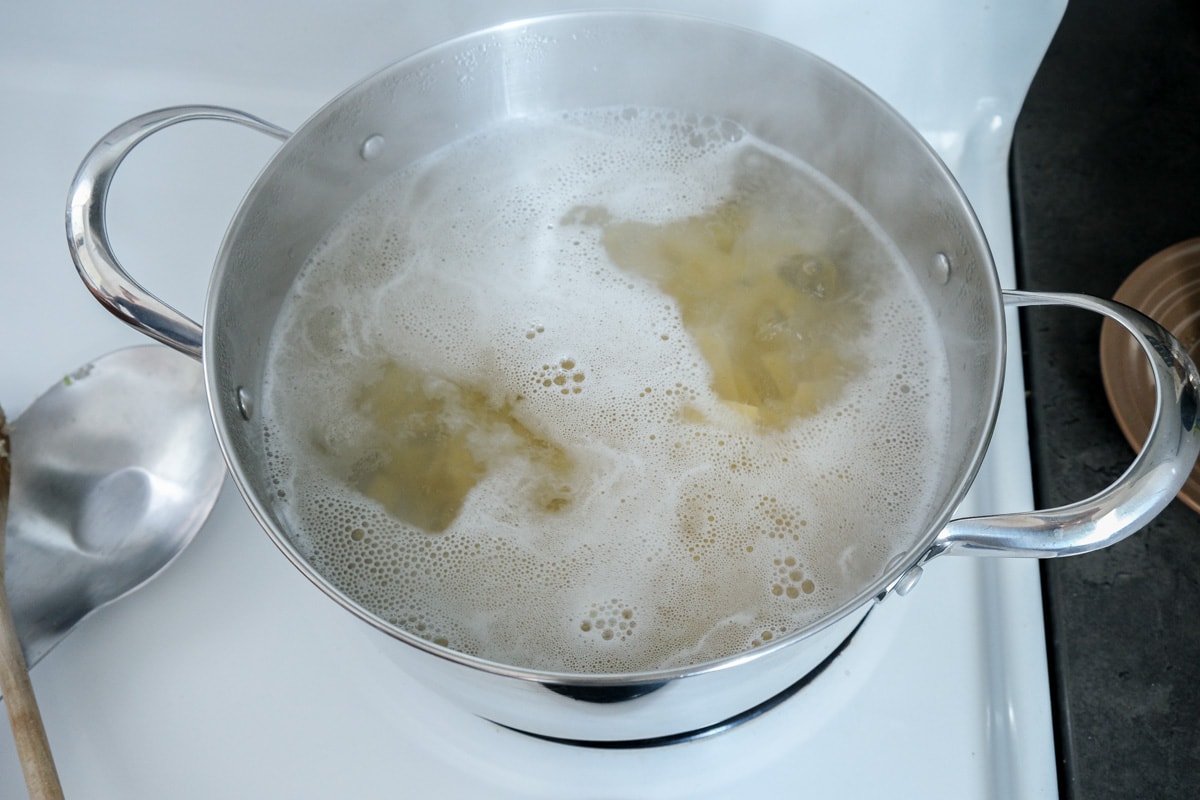
Meanwhile, bring salted water to a boil in a large pot and cook the pasta according to package directions until al dente. Then remove and drain.
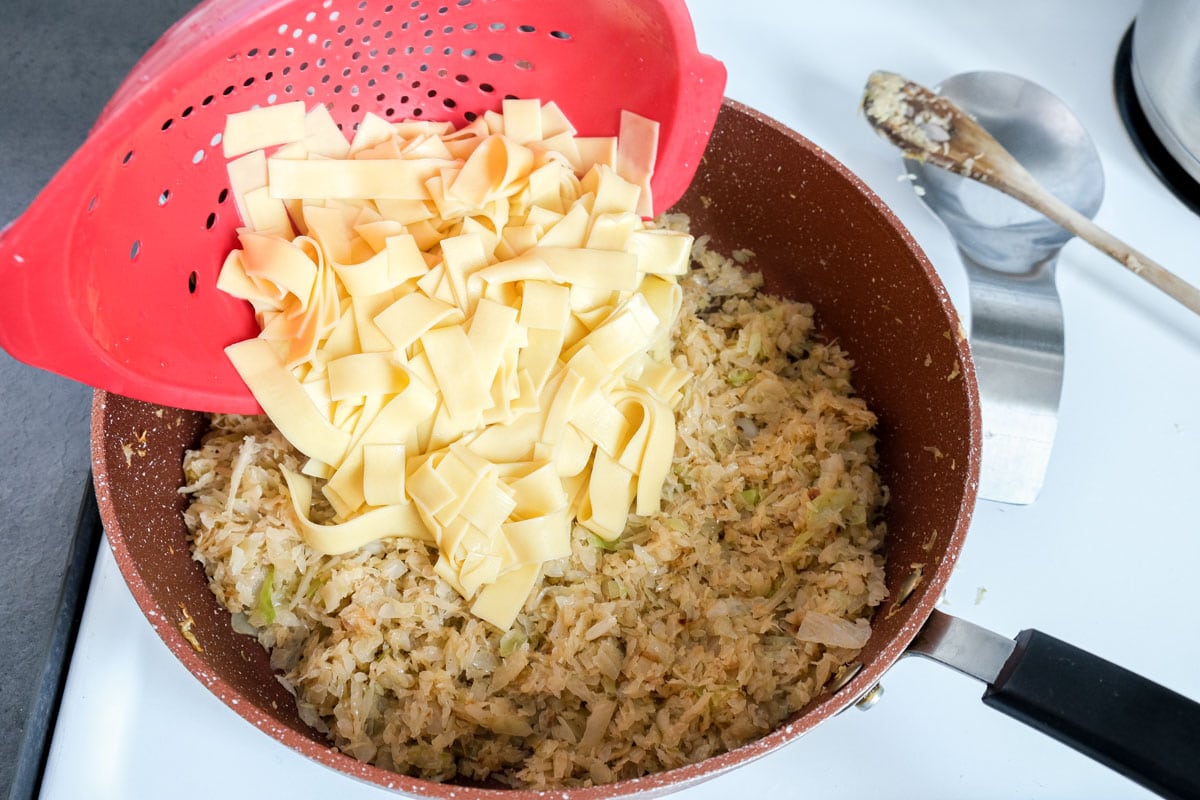
Once the cabbage is lightly browned, add the strained egg noodles to the pan.
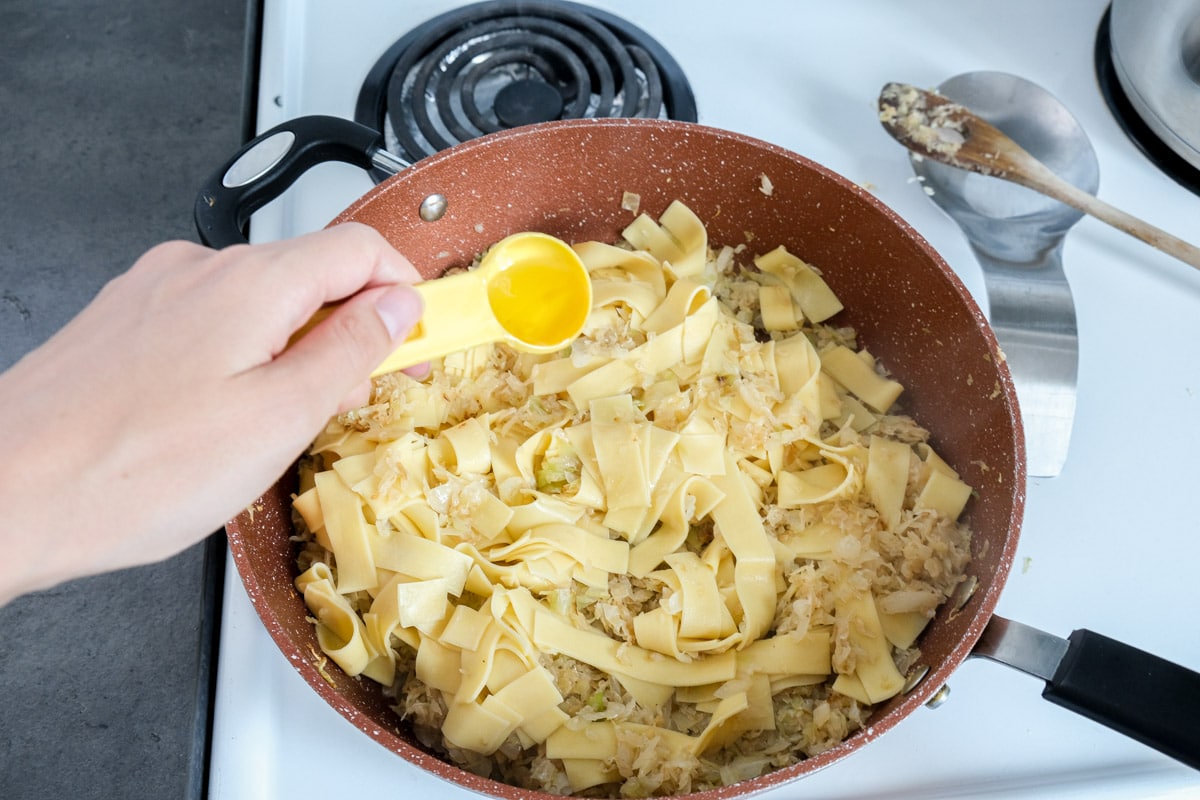
Add another tablespoon of oil (optional), and stir gently everything together until the cabbage and noodles are well mixed.
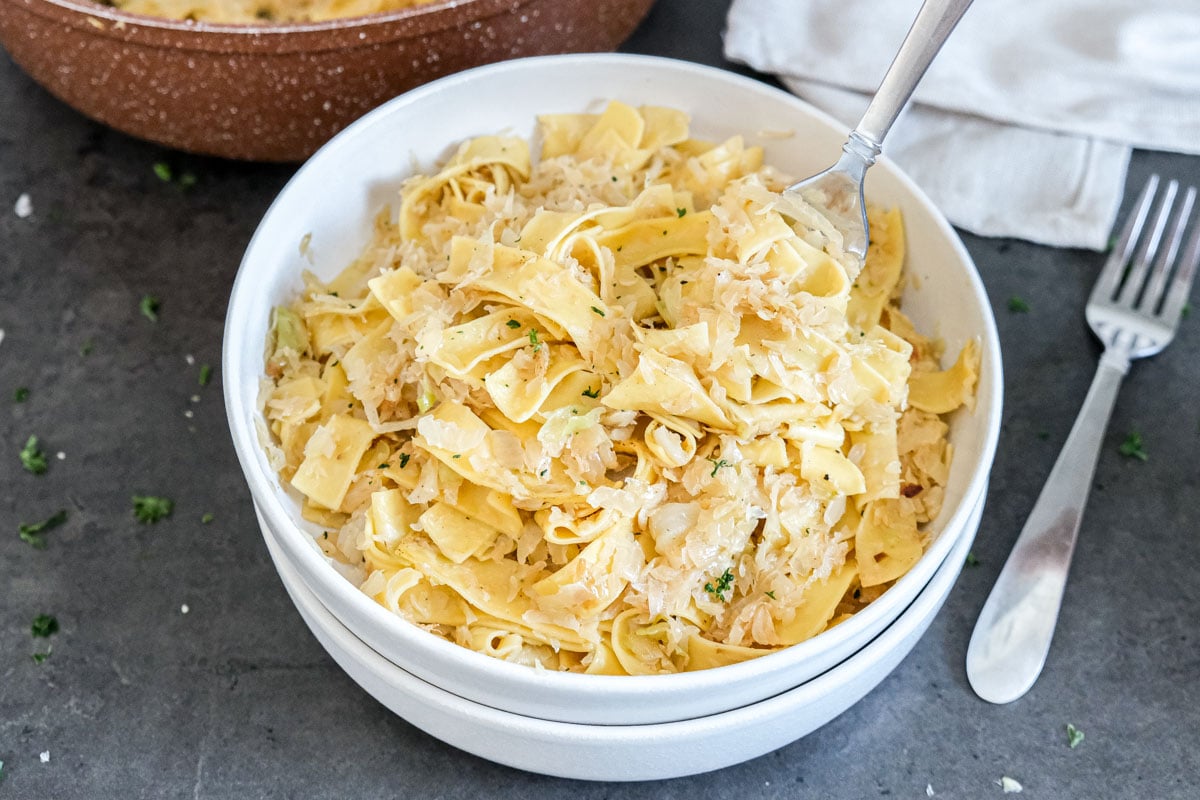
Taste and add more salt, pepper, and/or sugar as needed. You can serve the cabbage and noodles with sour cream (optional). Enjoy!
Storage Tips
These cabbage noodles store well. If you have leftovers (which is unlikely), you can store them in a sealed container in the fridge for up to 3 days.
To reheat, place them back into a frying pan and heat over low to medium heat until warm, stirring occasionally.
You may want to add a little more oil, but this isn’t always necessary.
FAQ
In Hungarian, the dish consisting of fried cabbage and noodles is called Káposztás Tészta. Literally, it means “cabbage” and “noodles”.
Related Recipes
If you liked this simple recipe for Hungarian cabbage pasta, here are some other Hungarian recipes that you might enjoy!
- Authentic Chicken Paprikash
- Hungarian Stuffed Peppers (Töltött Paprika)
- Hungarian Goulash
- Hungarian Beef Stew (Marhapörkölt)
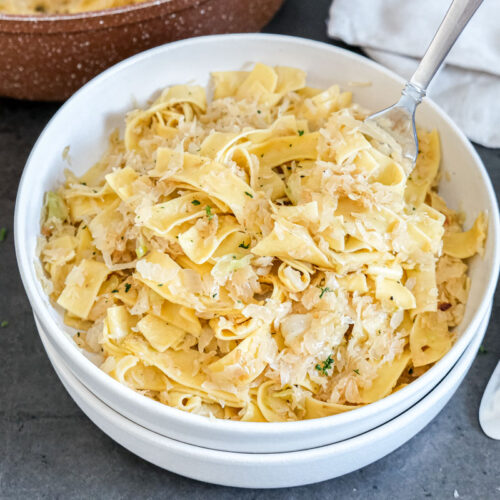
Hungarian Cabbage Noodles (Káposztás Tészta)
Ingredients
- 5 1/2 cups white cabbage, shredded (about 1/3 medium cabbage)
- 1 medium onion, diced
- 6 ounces egg noodles, (see notes)
- 1 tablespoon bacon fat, alternatively lard or oil
- 1 tablespoon oil, more to taste
- 1/4 teaspoon salt, more to taste
- 1/8 – 1/4 teaspoon black pepper, more to taste
- a pinch of sugar, optional
Instructions
- Heat oil and bacon fat (optional) in a large pan with high sides. Add the diced onion and sauté until translucent and starting to brown, about 5 minutes. Stir regularly.1 tablespoon bacon fat, 1 tablespoon oil, 1 medium onion
- Add the shredded cabbage, salt, pepper, and sugar to the pan. Cook over medium-high heat, stirring regularly, for about 10-12 minutes, until the cabbage is soft and beginning to brown. Then turn down the heat.5 1/2 cups white cabbage, 1/4 teaspoon salt, 1/8 – 1/4 teaspoon black pepper, a pinch of sugar
- Meanwhile, in a large pot, bring salted water to a boil and cook the pasta according to package directions until al dente. Then remove and strain.6 ounces egg noodles
- When the cabbage is lightly browned, add the strained egg noodles to the pan. Add another tablespoon of oil (optional), and stir gently until the cabbage and noodles are well mixed.
- Taste and add more salt, pepper, and/or sugar if needed. You can serve the cabbage and noodles with sour cream (optional). Enjoy!
Notes
- You can use classic Hungarian square egg noodles called kiskocka, extra broad egg noodles that are a little longer, other types of egg noodles, or noodles without eggs.
- Cutting the cabbage into smaller wedges makes it easier to hold and grate.
- You can use a (box) grater to shred the cabbage or dice it finely with a knife.
- Commonly, animal fat – often pork – is used to fry the onions and cabbage. If you don’t have any, you can use butter or oil as a substitute.
- Use a neutral-tasting oil, such as avocado, sunflower, or canola oil.
- You can add bacon if you like. Cut it into small pieces and add it when frying the onions. You can also add cut-up sausage, such as kielbasa.
- You can add a little bit of Hungarian paprika if you like.
Nutrition
This nutritional information has been estimated by an online nutrition calculator. It should only be seen as a rough calculation and not a replacement for professional dietary advice.
